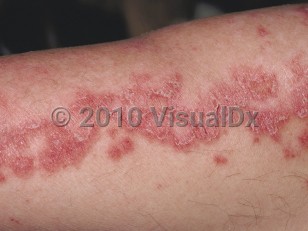Subacute cutaneous lupus erythematosus in Child
Alerts and Notices
Important News & Links
Synopsis

There is a strong association with anti-Ro/SSA antibodies and SCLE. In a small number of cases reported, both sexes seem equally involved, and there is no association with a particular race / ethnicity.
Systemic involvement is generally mild and less common in children as compared to adults, who may develop arthralgias, arthritis, and serositis.
Of note, certain drugs, such as antihypertensives (hydrochlorothiazide, calcium channel blockers, and angiotensin-converting enzyme [ACE] inhibitors), antifungals (terbinafine), NSAIDs, proton pump inhibitors (omeprazole), and, more recently, various chemotherapeutic agents (such as paclitaxel), tumor necrosis factor (TNF)-alpha antagonists, osimertinib, and pembrolizumab have been reported to trigger SCLE in adults. There has been at least one report of drug-induced SCLE in an infant, following treatment with omeprazole.
Codes
L93.1 – Subacute cutaneous lupus erythematosus
SNOMEDCT:
239891002 – Subacute cutaneous lupus erythematosus
Look For
Subscription Required
Diagnostic Pearls
Subscription Required
Differential Diagnosis & Pitfalls

Subscription Required
Best Tests
Subscription Required
Management Pearls
Subscription Required
Therapy
Subscription Required
Drug Reaction Data
Subscription Required
References
Subscription Required
Last Updated:09/21/2025

